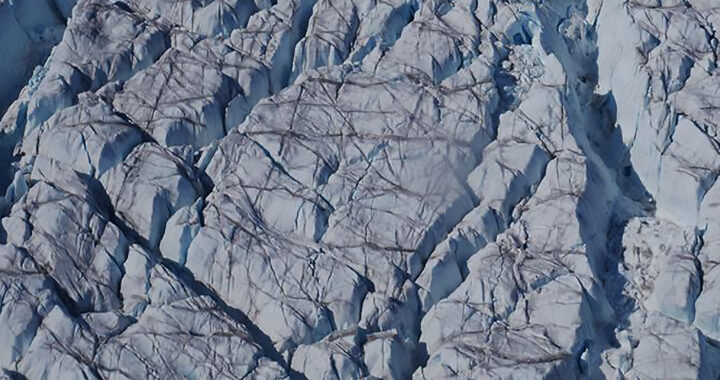The Greenland Ice Sheet is cracking open more rapidly. This observation comes from a large-scale study by T. R. Chudley, I. M. Howat, M. D. King, and E. J. MacKie of crevasses on the second-largest body of ice in the world. Details of their findings are discussed in a February 2024 article published in Nature Geoscience. Their study was funded by the Leverhulme Trust Early Career Fellowship, the National Aeronautics and Space Administration, and the National Science Foundation Office for Polar Programs.
Breaking the Ice: New Satellite Data Shows How the Greenland Ice Sheet is Splitting Open From Within
Background
Greenland has contributed approximately 14mm to global sea level rise since 1992. This trend continues to accelerate. Two key factors drive this trend. The first is the increasing surface melting due to rising air temperatures. This causes more ice to turn into liquid water that drains into the ocean. The second comes destabilized glaciers that result in a faster flow of ice into the ocean. This is caused by warming ocean temperatures. Both are consequences of climate change.
Nevertheless, the North American island contains enough ice to add 7 meters or 23 feet of sea level rise to the oceans if its entire ice sheet were to melt. Previous studies noted that it could contribute up to 30 centimeters or 1 foot to sea level rise by 2100. The rate at which its ice is melting and its impacts have been the focus of various research pursuits.
Researchers T. R. Chudley et al. studied surface crevassing on the Greenland Ice Sheet. Crevasses are wedge-shaped fractures or cracks that open in glaciers where ice begins to flow faster. These are key factors in ice mass loss but are not well-documented over time. Nevertheless, in their pursuit, T. R. Chudley and his team used over 8000 high-resolution digital elevation models captured by satellite imaging to measure the 3D volume of crevasse fields in 2016 and 2021
Key Findings
Analysis revealed that marine-terminating sectors with increasing ice flow had large crevasse volume growth. There was a 25 percent increase in the southeast sector of the ice sheet. However, in contrast, the central west sector saw a 14.2 percent decrease in crevasse volume. This is linked to a slowdown and thickening of the ice.
The aforementioned means that crevasse volume increased by up to 25 percent in fast-moving marine glaciers. Specifically, at the edges of the ice sheet where large glaciers meet the sea, accelerations in glacier flow speed were associated with significant increases in the volume of crevasses. These increases were offset by a reduction in crevasses at the fastest-flowing glacier in Greenland called the Sermeq Kujalleq.
Note that the offset resulted in a net change across the Greenland Ice Sheet at +4.3 percent. Recent indicators suggest that this balance may no longer hold. The flow speed at Sermeq Kujalleq has since begun increasing. This is an indicator that the period of balance between crevasse growth and closure on the ice sheet is now over.
Implications
The study of T. R. Chudley et al. underscores the direct link between the formation of crevasses in the Greenland Ice Sheet and warmer air temperatures and ocean waters. Previous studies associate this warming incident with human-induced climate change. Moreover, aside from this, it also highlights that flow acceleration in Greenland significantly increases crevassing. This can enhance ice sheet instability and mass loss on sub-decadal or less than 10-year timescales.
It also indicated that crevasses accelerate ice loss further by increasing ice calving, glacier flow speed or faster ice movement, and meltwater transfer or meltwater penetration into the ice sheet. Take note that faster ice flow also leads to more crevassing. This illustrates a feedback loop that can ultimately result in faster and more irreversible ice loss.
The aforementioned findings highlight the long-term impacts of climate change on Greenland and the risks associated with the Greenland Ice Sheet. Note that the study fills a crucial gap in glacier monitoring by showing that crevassing is not just expanding spatially but also deepening rapidly. The dataset produced during the pursuit can improve ice sheet behavior predictions. This is crucial for updating or revising existing climate models and forecasting future sea level rise.
FURTHER READING AND REFERENCE
- Chudley, T. R., Howat, I. M., King, M. D., and MacKie, E. J. 2025. “Increased Crevassing Across Accelerating Greenland Ice Sheet Margins. In Nature Geoscience. Springer Science and Business Media LLC. DOI: 1038/s41561-024-01636-6





